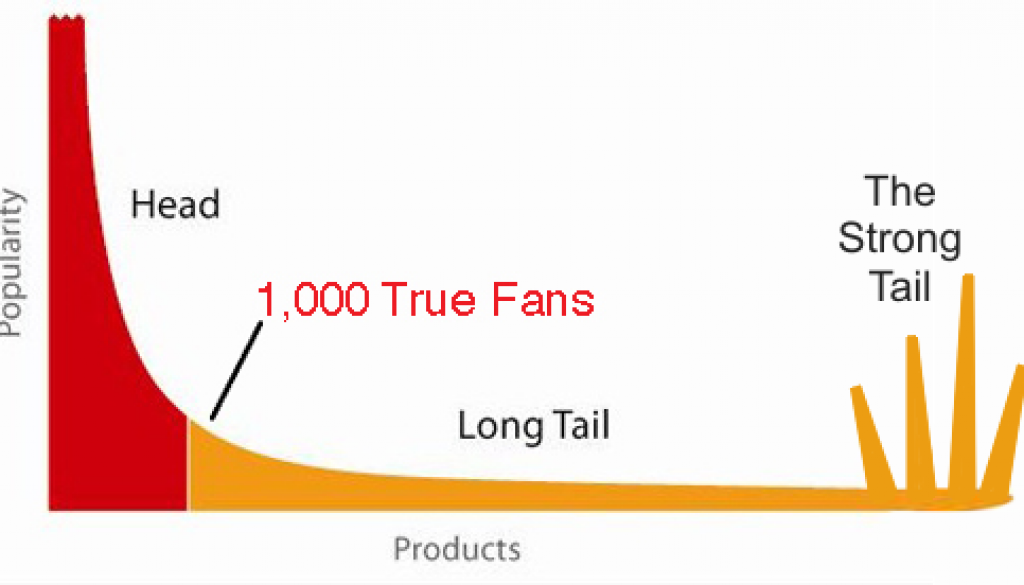The Strong Tail
You’ve heard the theory of The Long Tail, here’s my twist — The STRONG Tail.
The Long Tail explained, per Wikipedia:
The Long Tail is a retailing concept describing the niche strategy of selling a large number of unique items in relatively small quantities — usually in addition to selling fewer popular items in large quantities. The concept was popularised by Chris Anderson in an October 2004 Wired magazine article, in which he mentioned Amazon.com and Netflix as examples of businesses applying this strategy. Anderson elaborated the Long Tail concept in his book The Long Tail: Why the Future of Business Is Selling Less of More.
The Long Tail is thusly named because when charted, these smaller sales of a large number of items trails off into the distance like the long sloping tail of some prehistoric beast.

Keep this concept in the back of your mind as I tell you about another Wired writer’s thought provoking concept of “1,000 True Fans.” Kevin Kelly is the co-founder of Wired, and posits this theory:
A creator, such as an artist, musician, photographer, craftsperson, performer, animator, designer, videomaker, or author — in other words, anyone producing works of art — needs to acquire only 1,000 True Fans to make a living.
A True Fan is defined as someone who will purchase anything and everything you produce. They will drive 200 miles to see you sing. They will buy the super deluxe re-issued hi-res box set of your stuff even though they have the low-res version. They have a Google Alert set for your name. They bookmark the eBay page where your out-of-print editions show up. They come to your openings. They have you sign their copies. They buy the t-shirt, and the mug, and the hat. They can’t wait till you issue your next work. They are true fans.
A solid concept. I loved this idea as soon as I heard it. The theory rings true, because I know that I AM one of those 1,000 fans for a number of performers and writers (Hi Gitomer!) The 1,000 True Fans theory also fits nicely into the Long Tail continuum.
Which brings us my theory of The Strong Tail
The Strong Tail begins to form at the very end of The Long Tail. It’s made up of the amazing small quantity of super-fans who are willing to pay a premium for access to your product/service/presence. There are only a few of them, but they are willing to open their wallets wide for access to exclusive items.
If The Long Tail was represented by the tail of a Brontosaurus/Apatosaurus, The Strong Tail is represented by the tail of a Stegosaurus. It has the long sloping tail of the former thunder lizard, but the latter’s tail culminates in a set of spikes that reach upwards to match most of the overall tail height.

These ‘spikes’ are investments in rare one-of-a-kind signed editions, original art, limited edition prints, private performances, one-on-one consulting and conversations. These items come at the end of The Long Tail because there are very few of the items available, but the price to own these items (and the passionate people who must possess them) drives the profit on these rare items higher up the chart.
Instead of 1,000 True Fans — you may only need three of them to pay you for individual consulting advice. You may only need two of these people willing to pay you $50,000 each for a private corporate seminar. Or you may only need a single individual to shell out $100,000 for an original painting.
That’s The Strong Tail
What do you think of this newest adaptation?
Please leave a comment below!
Author’s note regarding the prior inclusion (now removed) of Seth Godin’s First Ten concept… Good feedback from my friend @morningtoast convinced me that including First Ten in the Long Tail chart was a bit confusing and didn’t really conform to the core concept because Seth was talking about winning your first 10 fans and riding their positive word of mouth to higher popularity and sales — make it run a reverse course on the Tail. I see what he means, and although I feel Godin’s First Ten is a cousin to the Long Tail, it made the chart a bit confusing to navigate and may have served to obfuscate the explanation of my Strong Tail concept — which was the whole point of this post in the first place.




